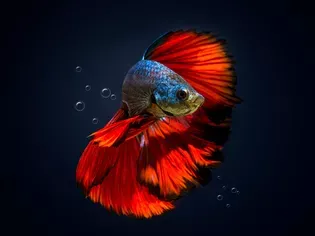The Best Environment for a Betta Fish
Updated on 04/26/24

Headline: The Ultimate Guide to Creating the Perfect Environment for Your Betta Fish: A Comprehensive Dive into Optimal Habitat Conditions
Introduction:
Embark on a captivating journey as we delve into the intricacies of providing the ideal living space for your vibrant Betta fish. This comprehensive guide will equip you with the knowledge and insights necessary to establish a harmonious and thriving environment for your aquatic companion.
Part I: Understanding the Betta Fish's Natural Habitat
To create an optimal environment for your Betta fish, it is essential to understand their natural origins. Bettas, scientifically known as Betta splendens, are native to the shallow, slow-moving waters of Southeast Asia's rice paddies, canals, and floodplains. These habitats typically feature:
* Warm, tropical temperatures: Bettas thrive in water temperatures between 75-80°F (24-27°C).
* Neutral pH: The ideal pH range for Bettas is between 6.5-7.5.
* Soft, slightly acidic water: Bettas prefer slightly acidic water with a hardness level below 10 dGH.
* Abundant vegetation: In their natural habitat, Bettas seek refuge and shelter amidst lush aquatic plants.
Part II: Establishing the Ideal Tank Setup
Armed with an understanding of the Betta fish's natural environment, let us now explore the essential components of a well-equipped tank:
Tank Size:
For a single Betta, a tank size of 5 gallons or larger is recommended. This provides ample space for swimming, exploring, and natural behaviors.
Water Filtration:
A reliable filter is crucial for maintaining water quality. Choose a filter with a flow rate that is gentle enough not to overwhelm your Betta.
Heater:
A heater is essential for maintaining a stable water temperature. Select a heater that is appropriate for the size of your tank.
Substrate:
Opt for a soft substrate, such as sand or fine gravel, which will not damage your Betta's delicate fins.
Live Plants:
Live plants not only provide hiding places and enrichment for your Betta but also help to keep the water quality optimal by absorbing excess nutrients. Java fern, Anubias, and Cryptocoryne are excellent choices.
Decorations:
Introduce decorations such as caves, driftwood, or ceramic pots, which offer refuge and stimulate your Betta's natural exploratory behavior.
Part III: Water Quality and Maintenance
Maintaining pristine water quality is paramount for the health and well-being of your Betta fish. Here are the key parameters to monitor:
Ammonia and Nitrite: These compounds are toxic and should be kept at zero PPM.
Nitrate: Nitrate levels should be kept below 20 PPM.
pH: The pH should be maintained between 6.5-7.5.
Hardness: Aim for a water hardness level below 10 dGH.
Regular water changes are essential to remove waste products and replenish essential minerals. Perform 20-30% water changes weekly.
Part IV: Nutrition and Feeding
A balanced diet is vital for your Betta's vitality and longevity. Offer a variety of frozen, live, or high-quality dry foods.
Frozen Foods: Bloodworms, brine shrimp, and daphnia are excellent frozen food options that provide protein and enrichment.
Live Foods: Live foods such as fruit flies or whiteworms can stimulate your Betta's hunting instincts and provide enrichment.
Dry Foods: High-quality dry foods specifically formulated for Bettas should be the staple of your Betta's diet. Choose foods that are low in fillers and high in protein.
Part V: Common Health Issues and Prevention
By providing an optimal environment, you can help prevent common health issues in Bettas. Here are some signs and symptoms to watch out for:
* Fin Rot: Characterized by damaged or disintegrating fins, fin rot is often caused by poor water quality or bacterial infections.
* Bloating: Abdominal swelling can indicate an underlying health issue, such as constipation or a bacterial infection.
* Ich: A parasitic infection that forms white spots on the body and fins, ich is highly contagious and requires prompt treatment.
* Eye Cloud: A milky or clouded eye can be a symptom of an eye infection or damage.
Regular veterinary checkups can help detect and address health issues early on, ensuring the longevity and well-being of your Betta fish.
Conclusion:
Creating the perfect environment for your Betta fish involves understanding their natural habitat, providing an appropriate tank setup, maintaining optimal water quality, offering a balanced diet, and monitoring their health. By following the guidelines outlined in this comprehensive guide, you can create a thriving haven where your Betta fish can flourish and captivate you with its vibrant colors and captivating behaviors.
Explore More Pets

Freshwater Aquarium Filters
How to Deal With Cloudy Aquarium Water

Saltwater Aquarium Filters
How Do You Remove Chloramines From Tap Water?

Freshwater Aquariums & Habitat
Can I Keep My Koi Fish Inside?

Saltwater Aquariums & Habitat
14 Best Floating Plants for Your Aquarium

Freshwater Fish Health
How to Treat Ich on Freshwater Fish

Saltwater Fish Health
Fin Rot in Aquarium Fish

Freshwater Aquarium Filters
How to Do Aquarium Water Changes

Saltwater Fish Health
How Do Fish Get Parasites?